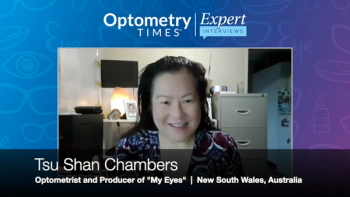
- October digital edition 2020
- Volume 12
- Issue 10
When a retinal detachment isn’t a retinal detachment
A wrinkled retina suggests detachment, but additional clinical findings prove otherwise
A 49-year-old patient who presented with a wrinkled retina shows how tricky retinal detachment can be to diagnose. Visual fields and clinical correlation were helpful in making the final diagnosis.
The patient whose fundus image is shown in Figure 1 had been followed for refractive care as well as retinoschisis. At the present visit at age 49, he attended for periodic evaluation. The patient did not report new or different visual or ocular symptoms. The anterior segment and interocular pressure (IOP) readings were withing the statistically normal range.
Case report
The fundus appearance is one of a wrinkled retina encroaching from inferiorly which was the site of previously diagnosed retinoschisis in the right eye. Visual acuity was correctable to 20/20 in each eye with moderate myopic refractive correction. The left eye showed no involvement of retinoschisis.
At this visit, visual field testing was ordered to assess functional impairment. The visual field of the right eye is shown in Figure 2. The uninvolved left fundus image and visual field are not shown.
The characterization of retinoschisis (senile, degenerative, or acquired) has been presented clinically and histologically decades ago,1,2 and more recently using optical coherence tomography (OCT).3 A common confusion of bullous retinoschisis is bullous retinal detachment as has been recently reported.4
Clinical features
The wrinkled retina in the present case may suggest retinal detachment, but several clinical features argue against this diagnosis.
First, the patient’s history is consistent with retinoschisis.
Second, the visual field result in the right eye shows an absolute depression while a fresh retinal detachment would more likely show a relative defect.
Third, the patient was not symptomatic for retinal detachment, nor was vitreous detachment or hemorrhage observed.
A recent report of a large series of acute posterior vitreous detachment both of the later clinical observations were identified as risk factors for retinal detachment.5 A simple clinical diagnostic that I have used is based on the anatomy of retinoschisis, a split between the inner and outer retinal layers, is to shine a directed beam of light at the area in question and note the response of the patient. The absolute scotoma of retinoschisis (no perception of the light) may be the first step in confirming retinoschisis.
Further characterization can be obtained from optical coherence tomography (OCT). In my experience, this is a difficult data point to generate. It requires wide pupillary dilation, a cooperative patient, as well as a patient and skilled technician. However, in questionable cases this may be a valuable study to conduct which may spare the patient in a primary-care scenario a consultation with a retina specialist. Kampetter and Jonas offer excellent clinical and OCT correlation along with histological examples for the interested reader.5 Widefield imaging may be useful in the clinical distinction between retinal detachment and retinoschisis, too.4
Treatment
Argon laser photocoagulation to collapse the cavity is futile, but application of a barrier posterior to the margin of the lesion has been suggested as prophylactically beneficial.6 Management of retinoschisis is generally observation until the macula is threatened or retinal detachment secondary to retinal breaks occurs. A complete guide to management can be found at the American Academy of Ophthalmology (AAO) Preferred Practice pattern website.7
Interestingly, this patient was reminded of the symptoms and risks of retinal detachment and asked to return if any appeared or in 1 year’s time. He returned within 3 months symptomatic for posterior vitreous/retinal detachment. A peripheral retinal tear was observed, and the patient underwent prophylactic argon-laser photocoagulation.
References
1. Yassur Y, Feldberg R, Axer-Siegel R, Silverston B, Manor R, Ben-Sira I. Argon laser treatment of senile retinoschisis. Br J Ophthalmol. 1983;67(6):381-384.
2. Straatsma BR, Foss RY. Typical and reticular degenerative retinoschisis. Am J Ophthalmol. 1973;75(4):551-575.
3. Kamppeter BA, Jonas JB. Optical coherence tomography of a peripheral retinal schisis with an outer retinal layer break. Acta Ophthalmol Scand. 2004;82(5):574-575.
4. Handa S, Arora A, Kumar N, Bansal R. Bullous retinoschisis. Indian J Ophthalmol. 2019 Oct; 67(10):1734.
5. Uhr JH, Obeid A, Wibbelsman TD, et al. Delayed Retinal Breaks and Detachments after Acute Posterior Vitreous Detachment. Ophthalmology. 2020;127(4):516-522.
6. Yassur Y, Feldberg R, Axer-Siegel R, Silverston B, Manor R, Ben-Sira I. Argon laser treatment of senile retinoschisis. Br J Ophthalmol. 1983;67(6):381-384.
7. American Academy of Ophthalmology. Senile Retinoschisis. Available at: https://eyewiki.org/Senile_Retinoschisis. Updated May 29, 2020. Accessed 7/15/20
Articles in this issue
about 5 years ago
4 vision-related causes of contact lens discomfortabout 5 years ago
Which patients are poor laser vision correction candidates?about 5 years ago
AI and the modern optometric practice restartabout 5 years ago
Where to begin with dry eye technologyabout 5 years ago
Pipeline: Potential new therapy coming for macular diseaseabout 5 years ago
What I have learned from the COVID-19 pandemicNewsletter
Want more insights like this? Subscribe to Optometry Times and get clinical pearls and practice tips delivered straight to your inbox.















































.png)


